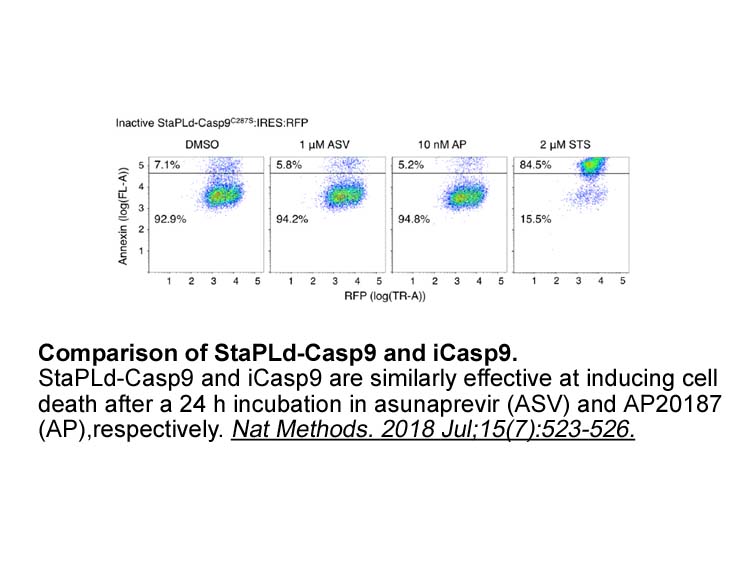Archives
Ghrelin is mostly known for
Ghrelin is mostly known for its orexigenic properties, whereas the role of DAG on feeding is controversial with studies claiming an orexigenic, anorexigenic or no effect (Inhoff et al, 2009, Toshinai et al, 2006). One of these studies was that of Toshinai and colleagues, who found a link between the action of DAG on feeding and the orexin pathway (Toshinai et al., 2006). They noted that intracerebroventricular (icv) administration of either ghrelin or DAG significantly induced feeding during both light and dark phases in rats. Contrary to ghrelin, icv administered DAG was able to induce feeding in ghrelin Propidium iodide deficient mice but not in orexin-deficient mice. Also pretreatment with antiorexin IgG, but not anti-neuropeptide Y IgG or control serum IgG, completely abolished DAG's food intake. DAG also increased intracellular calcium concentrations in isolated orexin neurons. In the light of these findings, the authors concluded that DAG-induced feeding is mediated by activation of the orexin pathway.
Ghrelin has been repeatedly reported to exert anticonvulsant effects in different models (Aslan et al, 2009, Lee et al, 2010, Obay et al, 2007). Biagini et al. tested the effects of ghrelin and DAG in the pilocarpine- and kainate-induced status epilepticus (SE) models by looking at the induction and latency to generalized seizures as well as induction and latency to SE, and mortality (Biagini et al., 2011). They found that while ghrelin failed to display any effect in these two models, DAG presented a trend in the prevention of pilocarpine-induced SE. With regard to kainate-induced SE, DAG was found to significantly delay the onset of SE in rats.
The initial aim of this study was to further characterize DAG's role on limbic seizure severity and to establish whether its anticonvulsant effect was due to the involvement of the orexin pathway. Here the rat intrahippocampal pilocarpine model for limbic seizures was used (Portelli et al., 2009). This model allows researchers to observe the sequential development of partial seizures to generalized seizures, and very rarely results in mortality. Unlike the systemic pilocarpine model for status epilepticus (Curia et al., 2008), the focal pilocarpine model used in this study is more considered as a model for repeated limbic seizures with secondary generalization. For this experiment, we also tested for the first time the effect of the dual orexin re ceptor antagonist almorexant against limbic seizures.
After noting that DAG's anticonvulsant effect did not involve the orexin pathway, we decided to rule out the involvement of the ghrelin receptor. To this end, seizure thresholds were determined using the intravenous pilocarpine tail infusion model in C57Bl/6 mice, ghrelin receptor knock-out mice and their wild type littermates. The mouse intravenous pilocarpine tail infusion model also allows the experimental study of the various behavioural stages accompanying seizure phenomena and to determine robustly whether test compounds are capable of altering seizure thresholds (De Bundel et al., 2011).
ceptor antagonist almorexant against limbic seizures.
After noting that DAG's anticonvulsant effect did not involve the orexin pathway, we decided to rule out the involvement of the ghrelin receptor. To this end, seizure thresholds were determined using the intravenous pilocarpine tail infusion model in C57Bl/6 mice, ghrelin receptor knock-out mice and their wild type littermates. The mouse intravenous pilocarpine tail infusion model also allows the experimental study of the various behavioural stages accompanying seizure phenomena and to determine robustly whether test compounds are capable of altering seizure thresholds (De Bundel et al., 2011).
Materials and methods
Results
Discussion
It is a widely accepted notion that DAG is unable to activate the ghrelin receptor and studies point towards the existence of a separate receptor that DAG binds to and possibly also shares with acylated ghrelin (Delhanty et al, 2012, Delhanty et al, 2013). Indeed, this led us to initially seek other mechanisms of action apart from the ghrelin receptor to understand how DAG elicits its anticonvulsant effect. However Heppner and colleagues recently observed, following in vitro and in vivo studies which also included ghrelin receptor deficient mice, that DAG regulated adiposity and peripheral glucose metabolism via ghrelin receptors present in the central nervous system (Heppner et al., 2013).
The concept of DAG having anticonvulsant properties is relatively new and had only been tested in a rat model of SE (Biagini et al., 2011). The anticonvulsant effects that DAG presented on seizures elicited by intrahippocampally administered pilocarpine make this peptide worthwhile for further investigations in the field of epilepsy. We observed that DAG required a higher concentration for significant seizure attenuation when compared to ghrelin (Portelli et al., 2012b). Further in the study, we also observed a significant increase in different behavioural seizure thresholds when DAG was administered in mice prior to continuous intravenous administration of pilocarpine. The type of models used in this study allowed us to assess the effect of DAG on seizure thresholds and seizure severity for the first time.